Lance Greenfield's Blog, page 62
July 10, 2016
Ecuador 1994 – Part Five
8th August – Monday
We breakfasted at the British Council on bacon, eggs, juice and coffee, with toast and marmalade at 7.30. After breakfast we went to catch a bus to the airport, but they were all full so we took a taxi. I sat in the front and became quite scared at the standard of driving. The brakes weren’t very good and the driver didn’t like stopping for lights.At one point, I saw passengers disembarking from a bus ahead of us and tried to get him to slow down. Instead, he altered course onto the opposite side of the dual carriageway so that he was driving against the flow of rush-hour traffic. Eventually, he made it back to the correct side of the road but he didn’t let up on the speed. I shouted at him to stop. When he did so, I reached across and snatched his keys. I told my Dad and brother to get out and take our rucksacks out of the boot. When they were safely on the pavement, I got out of the cab. The driver was furious and yelled at me to give him his keys and some money for the fare. Convinced that I was saving the citizens of Quito from certain death, I threw the keys down the drain.
With the driver still screaming at us, we managed to flag down another cab which was airport bound although already occupied. The German passenger was pleased to have rescued us.
We got to the airport at 9.15 and met two other travellers who were Yuturi bound. The first was a Chilean woman who had taught Spanish in Chicago for the past 10 years. She was called Sonia. The second was her colleague from Chicago who had grown up there, gone to university near San Francisco, and now taught in the 4th grade at a school in Chicago. Her name was Helena.
At 9.30 Anita, the tour organiser turned up, as promised, and gave us our tickets. She also checked us and our rucksacks in and saw us into the departures lounge.
There was a lot of confusion over which of the 3 gates we had to go through, but logically, since the passengers for Lago Alagrio departed through the gate marked ‘Coca’, so we departed through the gate marked ‘Lago Alagrio’.
As soon as the gate opened, the locals sprinted across the tarmac to board the plane. No seats had been allocated, so it was first-come-first-served. We “seasoned travellers” ambled over to the steps. When we got into the passenger cabin we were surprised to see that those who were not already seated were shaking the seats as if to test them. Some of the seats were attached to the floor by a single bolt! When we asked about this, it was explained that the seats were bought second-hand from decommissioned aircraft so some would fit the frame and other would not.
Dad and I managed to get seats which were quite solid but Oli was unlucky enough to get one that spun round on its single bolt.
We took off only 45 minutes late at 11.15.
Even the take off wasn’t without drama. The plane gathered speed and the curtain between the pilot’s cabin and the passengers blew out to the horizontal. “Don’t worry,” said the steward, “there is a window missing. It will be replaced in Quito and we don’t need it on the way down as we won’t decompress the cabins.”
Were we worried?
As we flew away from Quito towards the East, the Andes fell away into the relatively flat forests of the Oriente. As we approached Coca we could see the vast size of the Rio Napo. Coca is a ghastly shanty town and I was glad that after a short trip across town in what might pass for a bus, we only had to wait for about half an hour before we were aboard our ‘canoe’ heading down the Rio Napo towards the Rio Yuturi.
On the trip down the Rio Napo we were impressed by the size of the river and the sheer volume of water which must flow down it. It was full of trees and sandbanks and the cox had to keep switching sides to avoid these hazards. All the way down both sides of the river there were small settlements. There are also occasional oil wells. From time to time we saw turkey vultures and other birds.
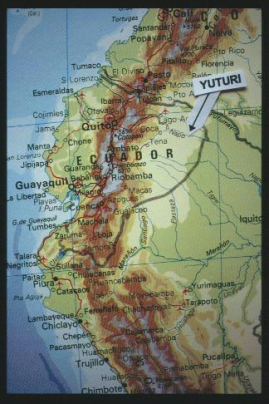 After four hours we turned into the Rio Yuturi which is much narrower than the Rio Napo (over 1 mile to about 30m), but has a slower flow. The birds were much more prolific on the Yuturi. The most impressive bird which we saw was the snake bird which we saw dive into the water from it’s perch on a branch about 4 metres above the surface. It is so called because it sits so low in the water that only its snake like head and neck show above the surface.
After four hours we turned into the Rio Yuturi which is much narrower than the Rio Napo (over 1 mile to about 30m), but has a slower flow. The birds were much more prolific on the Yuturi. The most impressive bird which we saw was the snake bird which we saw dive into the water from it’s perch on a branch about 4 metres above the surface. It is so called because it sits so low in the water that only its snake like head and neck show above the surface.
On arrival at the lodge we were surprised to see about a dozen well kept huts with palm roofs and bathrooms with showers. We were allocated to a 3 bed hut at the end of a row. Once we’d settled in we had about an hour to spare before supper, so we spent that time out on the river, near to the lodge, fishing with hook and line. There were a few bites, but nothing caught. It was just nice to enjoy the tranquillity of the river. To watch the sun birds sharing the sunset with us. On return to the lodge we had a very nice supper served to us – three courses and ½ glass of wine. After supper we met our guides, David Nash and a local indian called Innocentio. Our group consisted of we three plus Sonia and Helena.
Our first excursion was a night walk into the jungle behind the lodge. David explained to us how to hold the torch behind the eyes or just above the head, and look along the beam for the reflections of eyes looking back at us. We’d gone less than 100 yards and had stopped to admire a small tree lizard when I spotted a coral snake moving through the fallen leaves! This was only the third one our guide had ever seen and even Maier, a guide who had been at Yuturi for over two years, had only ever seen four. It turned out to be the best find of our whole trip. We watched it for a few minutes, then moved on. That night we saw lizards, praying mantises, crickets, katydids, spiders (including the “trash spider”) and stick insects. Dave also showed us the large centipedes which are in abundance in the jungle. “The difference between a centipede and a millipede,” he explained, “is not the number of legs, but that there are four legs per segment (two pairs of two) on a millipede, and only two per segment on a centipede.”


July 8, 2016
Ecuador 1994 – Part Four
7th August – Monday
Prior to returning the car to Budget at the airport we had the worst breakfast of all at El Cafecito. It took 35 minutes to deliver, and consisted of rubbery pancakes with maple syrup, fruit juice and foul, cold coffee. Budget gave us a lift back into town. As the odometer wasn’t working, the administrator, Sandra, (under)estimated our kilometerage as 400 for the round trip and gave us an effective $6 refund. So the cost of the whole trip was $211 + petrol.
We spent the morning down at the park of Amazonas. The art exhibition was pretty lousy apart from the work of one artist, Pedro Gomez, who had put together some beautiful 3-D look pictures using airbrush and chalk. He promised to send one, gratis, for Liz. We won’t hold our breath! I bought a small rucksack for Joy which I think she’ll love. We had pork and salad with ají off a stall for lunch. It was served by a woman who would have outweighed the pig she was serving.
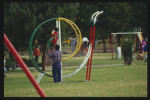

In the afternoon we headed for the park to the north of the city, towards the airport. There were all sorts of activities there. Stalls, hawkers, boating, fishing with small nets, horse-riding, football, volleyball, basketball. Everyone, of all ages and abilities, was having a good time. We decided to go to Reina Victoria for a Newcastle Brown before proceeding on to La Chosa for supper. Both were closed. We ended up at the Texan Grill where we had a good steak, but there were no postres. We dissolved our disappointment in a Marguerita at the Taco Factory where we met a Texan oil man who enthused about a sex show that he wanted to take us to. We left him to it.


We Are Sailing!

Imagine this. After years of preparation, MV Harmony of the Seas is about to sail from Southampton on her maiden voyage with over 5,000 passengers and 2,000 crew on board. The Captain and his senior officers have enthusiastically participated in all of the pre-cruise publicity. The passengers have been promised huge weekly refunds on their fares, freedom of movement around the ship and ports of call without the harassment of reverse agreements allowing non-passengers on board, and free trade wherever they may venture in the world.
As the ship leaves the berth, the Captain announces that he and his officers must now go ashore and that the passengers must, without charts or any planned course, leave the safety of the harbour and sail forth into the open ocean.
“But we don’t know how to run this ship. Nor do we know in which direction we should go!”
“Tough!” says the Captain. “We’re off. You elected to come on board. It’s up to you what you do now. Don’t worry. Everything will be much better than it was before. Goodbye!”
Now imagine this. After years of campaigning by the political leaders of the Brexit campaign, the United Kingdom is about to leave the EU for uncharted waters…..
As they disembark, the Brexit leaders sing in harmony: “Don’t worry. Everything will be much better than it was before. Goodbye!”



Stream of Consciousness Saturday: Last Supper…
Very cleverly written piece with obvious parallels to the crazy third world society across the pond.
Good grief, it’s already after four in the afternoon and I’ve only just seen the prompt Linda G Hill left us for our Stream of Consciousness Saturday post this week;
” “expect/unexpected.” Use either or both words in your post, or simply base your idea on them.”
Ok, let’s begin…
Last Supper.
Eldrin scanned the evening news-vid, noting the inordinate amount of coverage given to the latest fatal droid incident; hardly an unexpected story these days, what with the numbers of droids on the Parallel almost equaling those of Naturals, you were always going to get the odd bad owner who didn’t keep an eye on his property.
I mean, he thought to himself as he poured a second glass of wine, it’s not like it’s the droids’ fault, right? They were just tools when all was said and done; strong, intelligent tools, that was true, but objects to be…
View original post 776 more words


June 30, 2016
Review: Walter Minion’s Therapy

Walter Minion’s Therapy by Patrick D.T. O’Connor
My rating: 5 of 5 stars
Walter’s retirement leads to mental breakdown. His prescribed therapy is to sail around the world in a yacht called Therapy. As he leaves harbour, he observes his wife walking away on the arm of his psychiatrist. On his weird and wonderful voyage he has some fantastic adventures, is joined by a mysterious, beautiful siren and is boarded by pirates. There are massive highs and lows along the way and twists right up to the end. This is pure fiction as every part of the story is totally unbelievable, yet the reader is captured by the spirit and begins to wish that it were reality. By the end of the book, we are left wondering, “Was it real, or was it all just a dream?” A brilliantly unique read and the pace makes it very easy to relax into. Great therapy!
And if you like this one, you’ll LOVE Pat O’Connor’s second novel, which, characteristically of Walter himself, is actually the prequel to the first!
“Walter Minion’s Secret Life” is not available through Amazon, but you should be able to find a copy for yourself if you have a look at the Walter Minion web site.
Walter’s life is a continuous flow of fantasies as he makes his accidental mark on world affairs and gets himself involved in shaping modern history. Fantastic though the story of Walter’s life is, it is only a step or two removed from what would be a very ordinary life, and so it seems totally plausible.
From his boring life as a civil servant, Walter finds himself catapulted into the world of high espionage, being flown around the world and advising world leaders. This is an extremely entertaining read. The action never stops. The conclusion of each chapter leaves the reader anticipating the next.


June 28, 2016
Review: Pompeii

Pompeii by Robert Harris
My rating: 5 of 5 stars
This is the story of a latter day Super Mario, an Italian plumber who overcomes very difficult challenges to fix the water supply to Napoli and surrounding areas before the local volcano erupts to ruin everything for everybody.
OK, I admit that I am grossly trivialising a tremendous story, which is really about Marcus Attilius Primus, the aquarius, or chief water engineer, who is sent to the Bay of Naples to manage the water supply to all of the towns in the area. The main artery of the supply is the aqueduct, Aqua Augusta, which Attilius’s grandfather may have had a hand in building under the supervision of the great Agrippa. Water engineering has been the career path of Atillius’s family back through at least four generations.
From the off, Attilius is up against it. His predecessor disappeared mysteriously, and neither his team of engineers and slaves nor those masters who govern Naples and the surrounding area, are inclined to trust the new aquarius.
The first chapter opens with the horrendous execution of a slave who has been held responsible for the deaths of one of the local lord’s prize fish. The lord’s daughter, accompanied by the unfortunate slave’s mother, urgently seek the help of Attilius, who quickly discovers that it is something in the water which has killer the precious fish. But they are too late to save the wretched slave.
Events unfold and develop during the two days leading up to the famous eruption which buried Pompeii.
This is a rivetting read, if ever there was one. As you would expect, there are many dangers to overcome, and, as you read, you will be wondering who will survive and who will not. This does not become clear until the final pages. I have to confess that I was wishing for the demise of certain characters, whilst hoping for the survival of others. That is a sign of how well Robert Harris engages the reader with the actors in this story.
Definitely merits five stars.


June 27, 2016
Ecuador 1994 – Part Three
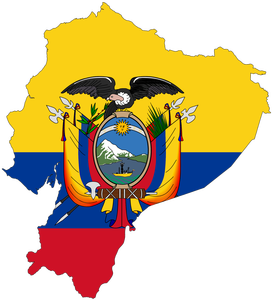
Further adventures of Tony Greenfield and sons in Ecuador in 1994.
Click on these links to read Part 1 and Part 2.
5th August – Friday
Got up at 5.30. Breakfast at 6, then out for a walk in the jungle of Mindo. We’d gone about 2km when I realised that I only had one film, so I ran all the way back to Guadual for a film and the long lens. When I got back, Dad and Oli were sitting on the roadside watching a toucan. We walked on for three or four kilometres up a good track. On the way, Oli and I caught a green snake about 18″ long and Dad photographed it. We also saw parrots, parakeets, humming birds, loads of butterflies, more toucans, some birds of prey, and some woodpeckers.
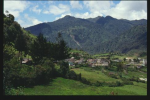
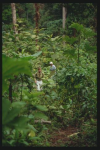

We left the main track and followed a path through the jungle. The cock on the rock had gone out for the day. We waited and looked for a while, but he was absent. We stopped to eat one of the cheese sandwiches that Elizabeth had prepared, and a Tango (Wagonwheel). At this point we noticed that our “Jungle Gel” anti-mosquito and sun block cream actually seemed to ATTRACT mosquitoes! We crossed a river and eventually found ourselves in a field surrounded by barbed wire! We sat on a log to watch the wildlife for about 20 minutes and didn’t even notice 2 cows creeping up behind us! When we crossed the fence at the top of the hill the path became indistinct so we found ourselves deep in the jungle again. It was a steep climb which led us to a woodcutter’s clearing. A large tree had been cut into good planks. These were in bundles of three and four with the remaining couple of inches between planks un-sawn. This was to allow the woodcutter to carry the planks down the hill through the jungle without letting them slip apart.
On the way down we met the woodcutter and his two dobermans. We scrambled down the hill, seeing a small tree lizard on the way, and came to a waterfall. The woodcutter re-appeared and led us past his house to the main path. We had lunch and took a leisurely stroll back to Mindo.
After supper and a shower we had a few drinks with the Enriquez family and friends. We met Eduardo (from the Banco Central de Ecuador) and his Spanish language student, Urs, who was a Swedish accountant. We drank some “Mindo whisky”. Dad went off to bed whilst Oli and I walked Luis (an Ecuadorian sergeant major) back to his billet on the other side of the village.
Returning, we met some of the friends from the earlier party at Guadual. They were now sipping Ron Cane (sugar cane rum) which they invited us to share. We stopped for a chat and had a beaker full each. It is very strong and threatened to melt the plastic beakers, but we were told that a drink called Tropico is even stronger.
6th August – Saturday
Oli and I were not 100%! We had serious headaches and maybe started the day at only 10%. We drove up the track to the main road and then on to Nanagalito where we filled up. Even though it was a “proper” garage with official signs, the petrol was still brought out in a large bucket and syphoned into the tank.
The drive to San Antonio was very spectacular. On the way into the town we met a procession which appeared to be part of some sort of harvest festival. The people were dressed up in all sorts of costumes including some who were dressed as clowns. They had a brass band of ancient instruments which played a repetitive, single-phrase “tune”. We went into the “Centre of the World” village where the Centre of the World Statue is built and the equator is denoted by a line of brickwork in the paving. Oli pointed out that the Equator is only 4″ wide at this point.
For lunch we had a toasted cheese sandwich, fruit juice and coffee in a restaurant. The music was turned off, at our request, by the daughter of the house. The mother came through and switched it back on, cursing her daughter for not doing her job correctly. There ensued a Fawlty Towers type of battle which resulted in us getting our own way with the music followed by a rather interesting chat with the mother.
After lunch we drove out to the Inca ruins of Pucara Rumicucho. We were shown around by Alexandra, who explained everything in rapid Spanish. She must have explained it all very well because I understood almost half of it! We all agreed that she was a “lovely mover”. The printed explanation of the ruins was penned by the same Eduardo who we had met the previous night.
We moved on to the pre-Inca ruins of Cochasquí. The drive was about 2 hours and was extremely spectacular. On a rough road, which zig-zagged down the side of a valley, we met a scramble bike, head-on, on a corner. He was on the wrong side of the road and only JUST avoided us. I don’t know who was more frightened, us or him. When we reached the bottom of the valley Oli and I crossed a bridge whilst Dad stayed further up the hill to photograph us doing so.
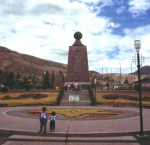
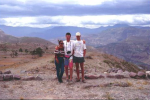
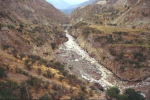
Eventually, we arrived at Cochasquí, only to find that it closed at 3.30, half an hour before our arrival. However, we decided to drive on to the site and were lucky enough to be able to tag on to a tour which had just started. The guide was called Juan. He was enormously enthusiastic and very knowledgeable. Firstly, he explained about a cross which was not intended to be a religious cross but to signify the four points of the compass. However, it had been interpreted by various peoples down the ages as a religious symbol of their own religion to suit themselves. We took part in a play act – closing our eyes, repeating an incomprehensible phrase three times, then throwing a small stone over our shoulders at the shrine.
The other people in the party were a local family. One of them was called Wilson and taught English. His English wasn’t too hot though but he seemed to understand Oli’s Spanish-spattered Italian.
Juan took us up to a small compound which contained two huts and about eight llamas. In the garden there were many plants which were commonly grown in pre-Inca times and used both as food and as medicines. Juan took us into the round hut first which was used as a kitchen and had several guinea pigs running around inside it. The locals liked their meat fresh! He showed us the stones where the Cara Indians would construct a tripod over the fire on which they would hang a cauldron type pot. He also showed us the various pots and cooking implements.
We moved on to the rectangular hut, which was the living quarters. Inside there were beds of woven palm leaf and what looked like a cot. This proved to be for storing potatoes. There were also a lot of interesting garden implements, tools and musical instruments.
As we walked down to the pyramids via a rickety bridge complete with roof, we admired the magnificent view. Juan said that it was possible to see the whole of Pinchincha Region from this site – a huge overstatement methinks!
The first pyramid which we came to had been excavated by Germans, who had exported all the most valuable gold and silver to Europe. Nevertheless, it was very interesting when Juan explained the purpose of the two circles which had been excavated. The larger was a Solar calendar to time the passing of the year; the smaller was a lunar calendar which timed the passing of the quarter. Juan took us on to show us a 3-D model of the site. Some of the pyramids had ramps up to 100m long which were used by processions during religious ceremonies.
The museum was closed but we were able to see a vertical excavation about 15m deep into a pyramid, which clearly showed that it had been built up over a very long period of time.
Juan didn’t want any money for the tour, but we pressed S/-10000 on him and gave him a lift home for his efforts.
The trip back to Quito was fairly uneventful. We had to stop to help Wilson and his family who hadn’t realised that they had a slow puncture. We were deliberately running the petrol tank low, so were a little worried when we got slightly lost on the way to El Cafecito. We dined at an awful steak bar where the tables rocked and the service was bad. The wine wasn’t too bad though.
To be continued . . .


June 26, 2016
Ecuador 1994 – Part Two
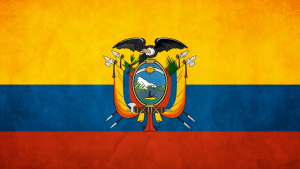 The continuation of my journal from the adventure that I shared with my father and brother in 1994.
The continuation of my journal from the adventure that I shared with my father and brother in 1994.
You can read Part One by clicking here.
3rd August – Wednesday
We had a breakfast of walnut and banana pancakes with maple syrup at the Magic Bean. Tried to hire a car from Ecuacar who tried to rip us off. $390 for 4 days. Budget gave us a Chevrolet Luv for $217 for 4 days. We drove up to the South American Explorers Club to pick up Dad’s passport, then headed for Otovalo and the Indian Market. I bought 15 necklaces for S/-20,000 down from S/-30,000. We had the customary chicken soup followed by meat and rice for lunch. A 10 year-old boy had kindly guarded our van for us whilst we browsed and ate. We gave him one dollar when we arrived, and another one when he was still there on our return to the van.
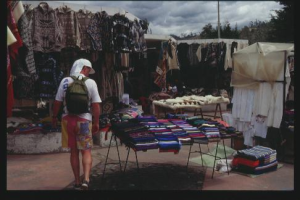
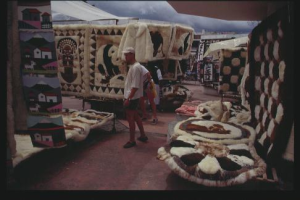
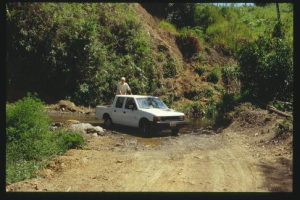
The plan was to drive from Otavalo to Mindo but we ended up going down a few miles of fairly rough tracks to a place called Garcia Moreno. The views along the way were absolutely marvelous. At one stage we descended over 2000m in one stretch of road. We came to a waterfall which had washed the road away.Behind the waterfall was a
Some time was spent discussing the insurance policy which came with the hire which demands that we should pay the first S/-4,000,000 on “death or total destruction”.
On the way up to Garcia Moreno, we stopped for a natural break, and, on looking back along the way we’d come, we were lucky enough to see four Andean condors circling in the distance. It is tremendously exciting to see these birds in their natural habitat!
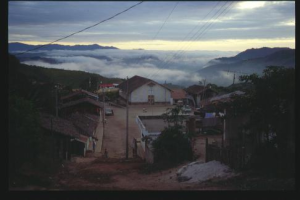
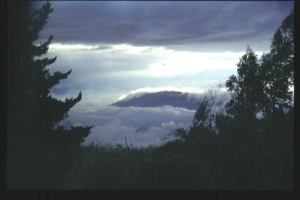
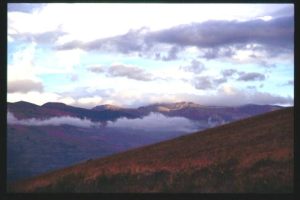
Sunset views from above Garcia Moreno
At Garcia Moreno we re-fueled using buckets and a syphon tube, and watched an extemely spectacular sunset before going back down the hill in the dark to Las Cabanas Rio Grande. It was S/-35,000 for one night for three, plus S/-26,000 for dinner and breakfast. The cabins were very good, but there were some silly New Yorkers next door to us. Oli and I took a walk down to the river whilst Dad talked to the American lawyer. We saw some red eyes on the other side of the river at water level. We also saw a toad and an owl (probably) on the way back.
4th August – Thursday
We had breakfast at eight after a stroll down to the river. We’d seen a hawk in a tree and some tadpoles and young frogs. We set off for the “short drive” to Mindo. At lunchtime, after a drive along mountain roads, we arrived at Nanegal. We’d seen a few turkey vultures along the way. We had also crossed a bridge made from planks, of which about 6 were broken. Oliver kindly walked across to guide me off on the best part of the road. Perhaps he’d volunteered not out of kindness, rather that he didn’t fancy being a passenger on such a dangerous crossing! My tactic was to drive across the bridge at full speed and try to put my wheels down on the highest parts of the ruts on the far side, thus keeping the sump off the ground. When we reached the other side of the ravine, we looked back at the bridge we’d just crossed and counted EIGHT broken planks. A few minutes further on, we met a man on a horse who we photographed. His name was Fagosto.
Once we’d left Nanagal we hit la careterra mejor a Nanagalito, where we picked up a soldier who showed us the way to Mindo. There was only one way down from the main road, and that track terminated at Mindo. We booked into the Guadual hostel at about 3 o’clock and had coffee. Dad had a shower, which involved lots of disconnection and connection of electrical appliances including the fridge and freezer. They had to be very careful not to overpower the circuit.
We went for a short walk in the jungle before dinner. On the way we called in at the laundry, which was run by Carmelita (aged 80+) to drop off Dad’s bag of dirty clothes. Elizabeth (our landlady) took us down there with her younger son. She has three daughters and two sons. In the jungle we saw a wild orange tree (which we later found out, through bitter experience, was really a lemon tree – the fruits just looked like oranges), an unidentified bird of prey, and a sapphire blue starling. The bird of prey had appeared right on cue just after I had said to the others, “look at that tree – surely there should be a hawk up there surveying the landscape?” What a fluke!
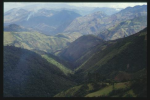
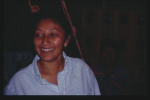
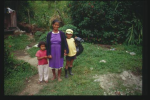
Tomorrow, we will head along the same track, but go a lot further to find the “Cock on the rock”. Elizabeth is going to prepare some cheese sandwiches for us. Her husband, Segundo Enriquez, was mending the windows when we got back. He is a surveyor, working on the roads.
Oli had a shower and we had a very good meal of soup followed by rice and lentils, washed down with a couple of bottles of Pilsener. The table was made of a beautiful, silky wood called teme. Once back in Quito we found out that, although the locals use the wood as a cheap, local resource, it would cost us around a thousand pounds to have a table made from teme and shipped back to UK. Elizabeth kept sprouting beetroot tops in small glass dishes on all the table tops. They looked very pretty.
To be continued . . .


June 25, 2016
Ecuador 1994 – Part One
I was just rummaging through some old files and came across my journal and some photographs from the trip that I made with my brother and father to Ecuador in 1994. Oli had just finished his degree in European business studies at Brighton and Torino universities. I was in the process of changing jobs. My Dad wanted an adventure and we wanted to join him.
It was to be our boys’ own adventure to the exciting country of Ecuador. Ecuador is divided into four distinct regions: the mountains – Andes; the Amazonian jungle – Rio Napo and Rio Yuturi; coastal plain – boring; Galapagos Islands – paradise on Earth!
We flew out on the last day of July. This is my journal.
Sunday 31st July (London – Madrid – San Domingo – Quito)
Gatwick had been expanded and was much more crowded than I have ever seen it before. Sarah kindly gave Oli and me a lift to the airport and came to see us off. On the Gatwick to Madrid flight we met Eric, a Frenchman who manages an advertising company in Madrid.
We had four and a half hours to wait in Madrid and spent it outside, watching life go by. The police were trying to keep abreast of the traffic problems with little success. They were taking their time getting a Mercedes towed away. It was double-parked and blocking a couple of other cars in. The owner returned with his family. Between them they eventually found enough money to persuade the policeman to dismiss the tow truck.
Once inside the departure lounge, we played rummy until we were allowed through to our flight. On the Madrid to San Domingo leg, the in-flight movie was the hilarious “Return of the Pink Panther” starring Peter Sellers. The service was lousy. The stewards and stewardesses were unsmiling and unhelpful. Iberia is a very poor airline to fly with. The San Domingo transit lounge was stylish and full of duty free shops. I planned to buy Joy’s cigarettes there on the way home.
Monday 1st August (Quito)
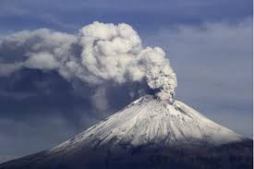
Mt Cotopaxi
The flight landed just about on time, and we could see Mt Cotapaxi on the way in. Its peak is the furthest land point from the centre of the Earth due to the Equatorial bulge. Dad met us and took us in a taxi to El Cafecito, a hostel run by Tony and Anna. We had breakfast of French toast with banana and honey, and coffee. We walked up the hill to the South American Explorers’ Club and met the administrators, Logan and Damaris. I read the noticeboard and some expedition reports. There was a notice to warn “Don’t go to the $*%#!$& club – a policeman’s son runs it – girl in jail over drugs – visit her if you can”.
After a short walk we caught the bus to North Quito. It cost S/-150 (Sucres), which is about 5 pence, for a half hour journey. People were jumping on the bus to sell things as we went along. This included a juice extractor for S/-1000 (33p) which I bought.
We walked back through the market and parks. On the way we had to wait for a train to move which had stopped in the middle of the road. The small Indian children were dressed just like the adults, even to the extent of wearing Trilbies or bowler hats.
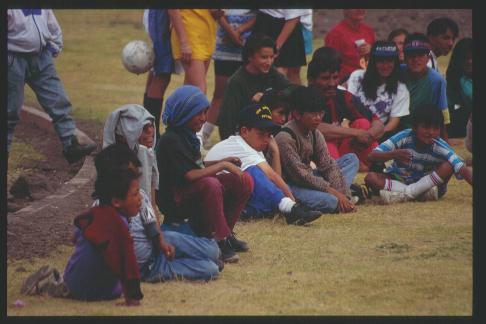
Watching volleyball in a Quito Park
For lunch we had fried fish and rice with various salads and a bottle of beer. That cost S/-5500 each (£1.60). I had a haircut on the way back. I got chased into the barber shop by a woman, which worried me a little. She turned out to be the owner and was called Margarita. She was a teacher of hairdressing and biology at a local school. I was taken into a special area in the shop, bumping my head on the low doorway on the way. There was no waiting for me! My hair was washed in a proper hairdresser’s basin with a bucket and jug – twice. It was cut by the student hairdresser who seemed afraid to cut too much off. I said “Mas corto” about twelve times, but each time she only cut off another half millimetre. The teacher took over and managed to cut my hair to as decent length. Margarita’s husband was a lecturer in psychology at the university. The haircut cost S/-4000. I gave them S/-5000 (£1.70) with which they were absolutely delighted. Not bad for one hour’s work for 2 people!
Our next stop was the Magic Bean, which is another hostel and was run by Logan’s brother, Bill. Whilst we had a snack and some coffee we played two games of Cuarto:

Rules: form lines of 4 or squares of pieces with same characteristics.

The Magic Bean
When we got back to El Cafecito we met Tony, the landlord. He was born in Ottawa, had lived for 10 years in Manchester and also in Marseilles. We asked him where we could go on a day tour and he recommended a place called Papallacta. He said it would be an experience to go by bus from Avenido 6 Deciembre. As things turned out, he was absolutely right!
We had dinner at La Chosa, which Dad had already recce’d. I had calve’s foot, peanut and corn soup, followed by corn pancakes, beer and a marvelous fruit drink with cinnamon called chicha de morocho. The cost was S/-17000 each (£5.50).
We slept in a four bunk room which we shared with a chap called Daron who was from Israel. Dad got up at 2am to go to the toilet. His movements woke us all up to hear the noise from next door. Someone was bonking in there. It was also a four bunk room, which was shared by three girls and one man. I wondered what the other two girls were thinking while the row was going on. The girl in the act just couldn’t keep quiet – “ah!” with every stroke, then a giggle and lots of whispers and “shh”s. After about twenty minutes there was a final, climactic, high-pitched “Oooooooh!”, followed by a last, lower-pitched sigh of “Aah”.
2nd August – Tuesday
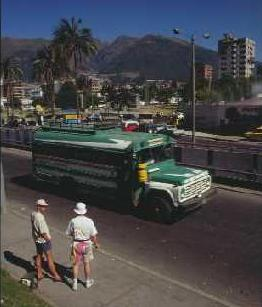
Oli and I waiting for the bus
I got up at 6.15 and went for a shower. Que sorpresa – no hot water! No pressure on cold so I spent 5 minutes filling up the wash basin for an all over wash in cold water. You try it sometime. It’s a never-to-be-repeated (if you can help it) experience.
We went up to the British Council for a breakfast of bacon and egg, toast and marmalade, and coffee. Paul and Irvana, a couple from London were running the restaurant. A short walk took us up to the Plaza Republica Argentina to catch the bus to Papallacta which left at 9.10am. It was already overcrowded when we boarded and there were chickens on the bus as well as people. Oli and I stood for the whole duration of the two and a half hour trip. Dad sat on the engine box directly behind the driver. This was very hot. Towards the end of the journey Dad drew the attention of the conductor to a leak which was coming from the engine box. We were alarmed by the thought that it could be inflammable fuel. Fortunately, it was only the result of the driver peeing himself as we drove along! The fare was S/-3000 each (one pound).
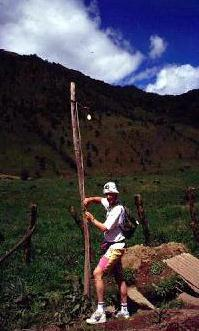
Lance the Lamplighter
Exploring Papallacta, we found the Science and Technology College and the school. We saw a Chinese lantern tree and we had the usual chicken and rice (pollo con arroz) for lunch. After lunch we walked the mile and a half up to the volcanic baths for which Papallacta is famed. On the way we found a street lamp which consisted of a 60W bulb atop a wooden pole. The switch was a break in the cable which had been looped so that the two broken ends could be hooked together.
The baths were very warm except for one which was fed direct from the river. We met a group of very young missionaries from North America. They believed that they had had a miracle. Their coach had crashed on the way back from Coca. One girl had “died” from internal injuries, but was “brought back by Jesus”.
On the way back to Quito the drivers swapped over, on the move, whilst heading directly for a wall. This action didn’t frighten us at all – honestly folks!
Back at El Cafecito we got changed to go out to the Colombian Steak House. Oli was badly sun-burned and Dad and I had also caught the sun. I had mixed grill which included cow’s intestine. Afterwards, we went to Big Dave’s place for a [Tequila] Marguerita. Dave and the barman told us of a few places we could visit which included Lago Quilotoa and Zumbulwa. We never actually got to either.
To be continued . . .
Excuse the quality of the photos. They were taken with my first ever digital camera. 1 Megapixel was considered high resolution in those days!


Ecuador 1994
I was just rummaging through some old files and came across my journal and some photographs from the trip that I made with my brother and father to Ecuador in 1994. Oli had just finished his degree in European business studies at Brighton and Torino universities. I was in the process of changing jobs. My Dad wanted an adventure and we wanted to join him.
It was to be our boys’ own adventure to the exciting country of Ecuador. Ecuador is divided into four distinct regions: the mountains – Andes; the Amazonian jungle – Rio Napo and Rio Yuturi; coastal plain – boring; Galapagos Islands – paradise on Earth!
We flew out on the last day of July. This is my journal.
Sunday 31st July (London – Madrid – San Domingo – Quito)
Gatwick had been expanded and was much more crowded than I have ever seen it before. Sarah kindly gave Oli and me a lift to the airport and came to see us off. On the Gatwick to Madrid flight we met Eric, a Frenchman who manages an advertising company in Madrid.
We had four and a half hours to wait in Madrid and spent it outside, watching life go by. The police were trying to keep abreast of the traffic problems with little success. They were taking their time getting a Mercedes towed away. It was double-parked and blocking a couple of other cars in. The owner returned with his family. Between them they eventually found enough money to persuade the policeman to dismiss the tow truck.
Once inside the departure lounge, we played rummy until we were allowed through to our flight. On the Madrid to San Domingo leg, the in-flight movie was the hilarious “Return of the Pink Panther” starring Peter Sellers. The service was lousy. The stewards and stewardesses were unsmiling and unhelpful. Iberia is a very poor airline to fly with. The San Domingo transit lounge was stylish and full of duty free shops. I planned to buy Joy’s cigarettes there on the way home.
Monday 1st August (Quito)

Mt Cotopaxi
The flight landed just about on time, and we could see Mt Cotapaxi on the way in. Its peak is the furthest land point from the centre of the Earth due to the Equatorial bulge. Dad met us and took us in a taxi to El Cafecito, a hostel run by Tony and Anna. We had breakfast of French toast with banana and honey, and coffee. We walked up the hill to the South American Explorers’ Club and met the administrators, Logan and Damaris. I read the noticeboard and some expedition reports. There was a notice to warn “Don’t go to the $*%#!$& club – a policeman’s son runs it – girl in jail over drugs – visit her if you can”.
After a short walk we caught the bus to North Quito. It cost S/-150 (Sucres), which is about 5 pence, for a half hour journey. People were jumping on the bus to sell things as we went along. This included a juice extractor for S/-1000 (33p) which I bought.
We walked back through the market and parks. On the way we had to wait for a train to move which had stopped in the middle of the road. The small Indian children were dressed just like the adults, even to the extent of wearing Trilbies or bowler hats.

Watching volleyball in a Quito Park
For lunch we had fried fish and rice with various salads and a bottle of beer. That cost S/-5500 each (£1.60). I had a haircut on the way back. I got chased into the barber shop by a woman, which worried me a little. She turned out to be the owner and was called Margarita. She was a teacher of hairdressing and biology at a local school. I was taken into a special area in the shop, bumping my head on the low doorway on the way. There was no waiting for me! My hair was washed in a proper hairdresser’s basin with a bucket and jug – twice. It was cut by the student hairdresser who seemed afraid to cut too much off. I said “Mas corto” about twelve times, but each time she only cut off another half millimetre. The teacher took over and managed to cut my hair to as decent length. Margarita’s husband was a lecturer in psychology at the university. The haircut cost S/-4000. I gave them S/-5000 (£1.70) with which they were absolutely delighted. Not bad for one hour’s work for 2 people!
Our next stop was the Magic Bean, which is another hostel and was run by Logan’s brother, Bill. Whilst we had a snack and some coffee we played two games of Cuarto:

Rules: form lines of 4 or squares of pieces with same characteristics.

The Magic Bean
When we got back to El Cafecito we met Tony, the landlord. He was born in Ottawa, had lived for 10 years in Manchester and also in Marseilles. We asked him where we could go on a day tour and he recommended a place called Papallacta. He said it would be an experience to go by bus from Avenido 6 Deciembre. As things turned out, he was absolutely right!
We had dinner at La Chosa, which Dad had already recce’d. I had calve’s foot, peanut and corn soup, followed by corn pancakes, beer and a marvelous fruit drink with cinnamon called chicha de morocho. The cost was S/-17000 each (£5.50).
We slept in a four bunk room which we shared with a chap called Daron who was from Israel. Dad got up at 2am to go to the toilet. His movements woke us all up to hear the noise from next door. Someone was bonking in there. It was also a four bunk room, which was shared by three girls and one man. I wondered what the other two girls were thinking while the row was going on. The girl in the act just couldn’t keep quiet – “ah!” with every stroke, then a giggle and lots of whispers and “shh”s. After about twenty minutes there was a final, climactic, high-pitched “Oooooooh!”, followed by a last, lower-pitched sigh of “Aah”.
2nd August – Tuesday

Oli and I waiting for the bus
I got up at 6.15 and went for a shower. Que sorpresa – no hot water! No pressure on cold so I spent 5 minutes filling up the wash basin for an all over wash in cold water. You try it sometime. It’s a never-to-be-repeated (if you can help it) experience.
We went up to the British Council for a breakfast of bacon and egg, toast and marmalade, and coffee. Paul and Irvana, a couple from London were running the restaurant. A short walk took us up to the Plaza Republica Argentina to catch the bus to Papallacta which left at 9.10am. It was already overcrowded when we boarded and there were chickens on the bus as well as people. Oli and I stood for the whole duration of the two and a half hour trip. Dad sat on the engine box directly behind the driver. This was very hot. Towards the end of the journey Dad drew the attention of the conductor to a leak which was coming from the engine box. We were alarmed by the thought that it could be inflammable fuel. Fortunately, it was only the result of the driver peeing himself as we drove along! The fare was S/-3000 each (one pound).

Lance the Lamplighter
Exploring Papallacta, we found the Science and Technology College and the school. We saw a Chinese lantern tree and we had the usual chicken and rice (pollo con arroz) for lunch. After lunch we walked the mile and a half up to the volcanic baths for which Papallacta is famed. On the way we found a street lamp which consisted of a 60W bulb atop a wooden pole. The switch was a break in the cable which had been looped so that the two broken ends could be hooked together.
The baths were very warm except for one which was fed direct from the river. We met a group of very young missionaries from North America. They believed that they had had a miracle. Their coach had crashed on the way back from Coca. One girl had “died” from internal injuries, but was “brought back by Jesus”.
On the way back to Quito the drivers swapped over, on the move, whilst heading directly for a wall. This action didn’t frighten us at all – honestly folks!
Back at El Cafecito we got changed to go out to the Colombian Steak House. Oli was badly sun-burned and Dad and I had also caught the sun. I had mixed grill which included cow’s intestine. Afterwards, we went to Big Dave’s place for a [Tequila] Marguerita. Dave and the barman told us of a few places we could visit which included Lago Quilotoa and Zumbulwa. We never actually got to either.
To be continued . . .
Excuse the quality of the photos. They were taken with my first ever digital camera. 1 Megapixel was considered high resolution in those days!







